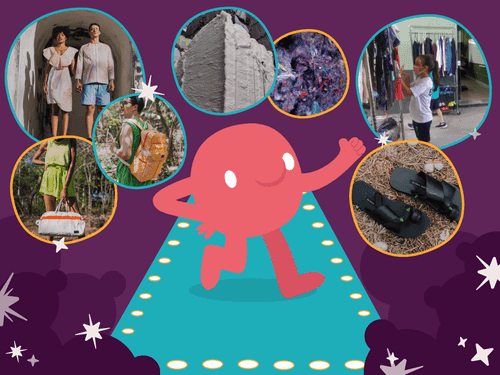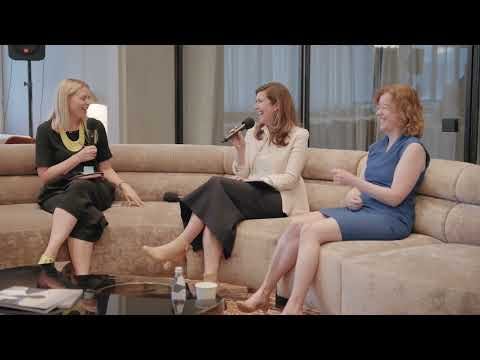
16/03/2023
Circular Fashion is more than a trend
By Julliana de Melo, special for Circular Movement
Against the grain of the fast fashion model and the accelerated disposal of clothes, another way of thinking, producing and dressing has been taking up more and more space in factories, catwalks and racks of stores, as well as in the awareness of consumers. Circular fashion sees the options of the entire production chain and prioritizes the use of recyclable and recycled materials in the creation of products with a longer and more sustainable life cycle, as proposed by the precepts of the Circular Economy.
Designers, stylists and some retail chains are already joining the movement to print the eco-friendly seal on their clothes and production chains. The initiatives, although insufficient, bring a little hope to the environment, which is impacted by the fashion and textile industries.
Just to give you an idea of the problem: processes using chemicals in dyeing are responsible for about 20% of water pollution, according to a report by the Ellen Macarthur Foundation (2017). The sector is considered the 2nd most polluting on the planet and, according to data from the United Nations Environment Organization, it is responsible for 8% to 10% of global greenhouse gas emissions, in addition to generating a large amount of waste.

According to the Fios da Moda 2021 report, carried out by the Modefica Institute (@modefica) in partnership with the Getúlio Vargas Foundation (FGV), around 9 billion pieces of garments were produced in Brazil in 2018. Many of them remain in the back of closets until they are discarded. Every year, more than 4 million tons of textile waste - old clothes, scraps from the fashion industry and leather goods - end up in landfills. That is so much pollution - and waste!

In circularity, “waste” does not exist. Waste becomes raw material for companies to practice upcycling, a process that reuses materials without loss of value or quality. The challenge, according to Mariana Amazonas, ecodesigner and co-founder of the regenerative fashion company RODA, is to achieve waste uniformity to be competitive and economically viable. The solution has been to bet on leftovers from the industry, which generates more than 30% of waste, and has a greater capacity for uniformity. "Thus, we are able to produce models and keep them in line, without having a development cost for each batch."
The environment wins, the business wins and also the consumer, who finds unique and personalized pieces, with added environmental value. Check out some circular fashion initiatives below:
Renovar Têxtil
 https://www.instagram.com/renovartextil/
https://www.instagram.com/renovartextil/
Located in the east zone of São Paulo, Renovar Têxtil is an industry that has been operating in the recycling of textile waste for 35 years. For them raw material is whatever is discarded by other industries in the spinning, weaving, carpet and clothing manufacturing chain. They are the so-called pre-consumer waste made up of leftover fabrics, threads, hems and tows.
This input, which is the result of purchases or donations from several suppliers that are committed to reverse logistics projects, undergoes a defibration process and is transformed through mechanical recycling into recycled fibers. The entire operation offers lower environmental impact, since water is not used - nor chemical products.
In one year, according to an internal balance sheet, the company processes, on average, around 1.5 million tons of textile waste classified by color and/or composition, which could end up in landfills. Back on the market, however, the new fibers increase their useful life and are sold as upholstery for pillows and plush, acoustic and thermal blankets, felts, automotive plates, etc.
In recent years, the challenge has been to increase production capacity and recycle a greater amount of textile waste to serve different segments. “For the company, recycling is very important, the soul of our business, but it is only viable when the market absorbs it in the manufacture of new products, that is, when there is demand”, explains Daniela Passatuto, manager of Renovar Têxtil.
Roda
 https://www.instagram.com/vem.pra.roda/
https://www.instagram.com/vem.pra.roda/
Do as nature does. This is what drives RODA, a company from Pernambuco that recreates fashion from clothes forgotten in the closet, textile waste and even from the automotive industry. Like the collection made with Jeep, which draws attention with products such as skirts, coats, sandals, backpacks and bags made from seat belts, airbags, leather and other leftovers from car production.
Collaboration with the multinational Stellantis, owner of Jeep, which has a factory in Zero Landfill principle in Goiana, in the North Forest of Pernambuco, proves how it is possible to be sustainable and give a nobler destination to waste.
According to Mariana Amazonas, ecodesigner and co-founder of RODA, the concept is Circular Economy. “It is to think about the design of the products, also thinking about what they can become in the future.” And, when thinking about new uses, it is possible to add more value, generate income and social engagement.
The initiative began in 2019, with a pilot regenerative design project in Caxangá, Recife, in partnership with seamstresses and community participation. At the end of 2020, motivated by the partnership with Jeep, it held a creative lab that brought together designers and artisans to rethink products. “Industrial linearity makes people lose the ability to create; and our goal is to keep creating really new things, made to last”, says Mariana.
In one year of operation, completed in November 2022, the company had the involvement of more than 50 professionals and transformed 7 tons of waste into 5 thousand products, which were created and sold. With less carbon emissions and without having to exploit new natural resources. Currently, it is conducting consultancy and closing partnerships with other industries, to launch new products and keep the wheel of sustainability turning.
Roupa Descolada
 https://www.instagram.com/roupa_descolada/
https://www.instagram.com/roupa_descolada/
Before being a sustainable fashion project, Roupa Descolada was a seed. Idea that sprouted from a teenager for a school tournament, right at the beginning of the pandemic; received support from adults to grow and become a reality; and the engagement of the entire community to multiply. This story began with Pedro and his mother, Alinye Amorim, in São José dos Campos, São Paulo.
A computer engineer by training and a Girl Scout at heart, Alinye wore - literally - the shirt to help publicize her son's action, then 12 years old. “In one year, he grew 20 cm and lost all his clothes and shoes. He imagined what it would be like if he could trade clothes with other people.” And so they did. But not alone.
After the tournament, Alinye looked for one of the enthusiastic teachers to carry out the work and, in the Pastoral da Educação of the city, they won the 1st headquarters, in the Franciscan school. It was August 2020. Since then, Roupa Descolada has become an NGO and gained two more units: one at Pedro's school, in the same year; and another in the parish, at the end of 2022. The latter is open to the general public.
In schools, in addition to weekly exchange fairs, students participate in lectures to rethink consumption habits and the impact on the environment. Garments without approval are customized, within the Circular Economy concept. “The T-shirt will no longer live as a T-shirt, but it doesn't have to become trash. It can become raw material for an ecobag, which will last a long time, and then it can even become a mopping cloth, and even not used at all.”
In one year of the project, more than 4,000 items were exchanged, including clothes and shoes, involving more than 700 users. With this attitude, more than 14 thousand kg of CO2 were no longer emitted into the atmosphere (equivalent to 100,000 km driven by a gasoline car) and 20 million liters of water were saved. For the next phase, since it does not have financial support, Camisa Descolada wants to offer mentorship and is seeking supporters to take the initiative to more schools and become sustainable.
To follow the thread
Discover more initiatives that have made a difference in circular fashion:
- Bemglô
- Circulô
- Comas
- Cotton Move
- Natural Cotton Color
- Projeto Ovo
- Refazenda
- Repassa
- Revoada
- Roupateca
- SustexModa
- Transmuta
What is the circular economy?
The Circular Economy proposes a new look at our way of producing, consuming, and disposing, in order to optimize the planet's resources and generate less and less waste. In other words, an alternative model to the Linear Economy - to extract, produce, use and discard - which has proved to be increasingly unsustainable throughout history. In the Circular Economy, the goal is to keep materials in circulation longer by reusing them until nothing becomes waste! For this model to become a reality, we all have a role to play. It is a true collaborative circle, which feeds itself, and helps to regenerate the planet and our relations.
Learn about Circular Economy
If you are interested in learning more about this topic, visit Circular Academy , the first free Latin American course on circular economy aimed at general audiences. All of us, in partnership and collaboration, can make a difference in building a more circular planet.

